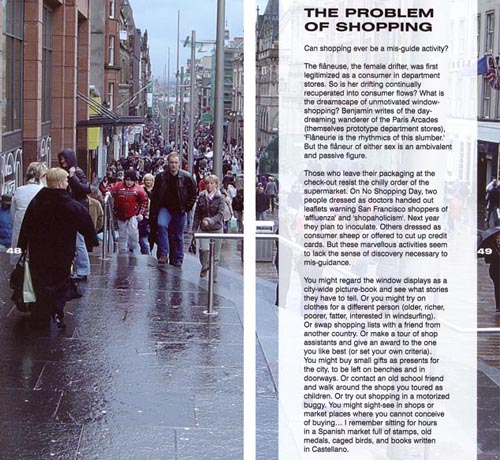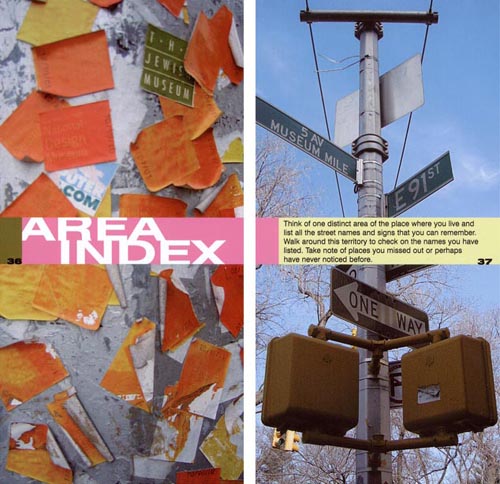Using Wrights & Sites new "A Mis-Guide To Anywhere", city dwellers around the world can unlock a "mental toolkit" that will help them discover the extraordinary in the seemingly mundane urban experience, writes author Phil Smith.
 Imagining "Utopia" usually involves erecting borders and putting a distance between now and the future, gating an ideal community with an identity separate from the present reality. I am part of an ongoing project that has accidentally arrived at a quite different kind of Utopia -- not mysterious and distant, but specific. The result has been neither a literary "no-place" nor a model for everywhere, but a mobile and transitory provocation: "A Mis-Guide To Anywhere" -- a search for the utopian in the everyday urban experience.
Imagining "Utopia" usually involves erecting borders and putting a distance between now and the future, gating an ideal community with an identity separate from the present reality. I am part of an ongoing project that has accidentally arrived at a quite different kind of Utopia -- not mysterious and distant, but specific. The result has been neither a literary "no-place" nor a model for everywhere, but a mobile and transitory provocation: "A Mis-Guide To Anywhere" -- a search for the utopian in the everyday urban experience.
This "Mis-Guide" is almost a guidebook, but not to any particular place. The journeys it suggests are to feelings, the routes it recommends are tasks or indulgences. The producers are Wrights & Sites, artists and performers with a particular interest in place and space, and an antipathy toward their generalization.
Moving away from the illusory "empty space" of theatre stages, we began to create "site-specific" performances on river boats, in abandoned electricity-generating stations, in natural history collections, attics, and back gardens. But we were frustrated. The most intense parts of our work were the explorations of our sites, not the performances in and about them. We began to walk, inviting our audiences to explore our city -- Exeter, UK -- with us, slowing down, turning up the unexpected in the over-familiar, the irrational in the banal, the operationally symbolic in the trashed, the big lie in the heritage.
During our perambulations, the unexpected and unique turned up at seemingly every corner. A skeleton in a pub cellar led to us to the discovery that the smoothly mown grass of the city's most popular meeting place covers 100,000 bodies. We found a 'graveyard' of crated civic statues; a set of completely unrecognized and unmapped 'green' routes -- of spinneys, tree-lined roads, and overgrown verges -- winding from the edges of our city almost to its very heart; and a 'sanctuary' for wild flowers on an industrial estate.
We deployed the same intensity and specificity to these wanderings as we had to the exploration of our performance sites. Indeed, the walks were often performative -- we built new structures from burned ruins, inconveniently celebrated statues due for removal. We diffused our energies to a growing number of explorers, developing this walking not simply as a series of events, but as a mental toolkit that could be carried and deployed at any time, a way of re-inventing seemingly mundane city life, from momentary diversions from shopping to the re-making of habitual routes into snaking physical pleasures.

After developing an Exeter-specific "mis-guide", we decided to make our next guide a generic one. We found inspiration in others who regarded their walking as art, or activism, or a form of mobile architectural or urban re-designing, walkers who saw the everyday walking of the city by its citizens as part of the daily re-making of the city, a re-making that is as significant to the city as the political and planning decisions about its future.
But we were most inspired by the urban terrain itself. Whether in Exeter or in Shanghai, we found the urban landscape unpredictable, liable to turn from fine detail to a flash flood of sensations in a few steps...
...On quiet canal banks outside Exeter, drunken land rovers would erupt at us from the reeds.
...Tucked behind a cemetery noticeboard on the Rue Des Morts on the British island of Guernsey, I found an otherwise blank card: "one day we will find out what reallyhappened on that dreadful night."
...In Exeter, a notice marked the site of "the only Islamic-influenced architecture in the Westcountry, demolished 1968" -- but we found another in a nearby seaside town.
...A plaque of promises for the millennium lay, discarded, behind a Channel Islands tea shop.
...And in wooded heights above Zurich, we came face to face with a caged tiger.
To call these places "anywhere" seemed an act of contempt, but any sense of guilt quickly faded. We were not labeling specific sites as standard "everywheres", but as a set of uneven and inconsistent "anywheres" -- partly experienced, partly imagined. Places you could walk without fear, places where dumped mattresses were opportunities to dream. These very qualities began to seem hopeful, even utopian, when subjected to our wanders in Shanghai, Paris, Munich, Copenhagen, San Gimignano, on small islands, in rural Zambia, and close to home.

When we began, we worried about the chronic limitations of our experience, but we have since found ourselves increasingly part of the unplanned project of an international matrix of explorers and walkers, a "community" too unstable to tolerate either borders or leadership, on a terrain constantly shifting and welcoming, all of us inspired by an idea and a practice: the everyday re-making of space.
And this is where the "Mis-Guide" project comes in. Our first work had been to turn ourselves from actors into signposts, pointing to what is unseen, unvalued, and unexpected. But now we have traveled a step further -- to make, and suggest the active making, of "anywheres" -- to imagine an architecture that is, in the words of Francesco Careri, "taking a step in the direction of the path."
Anyone can explore an "anywhere". Exploring for "anywheres" is a pleasure to be enjoyed for itself, but it can also be the pre-amble to sharing, and the instrument for a re-shaping, a re-planning, or a re-building of environments. You can introduce your "anywheres" to others, circulate maps of "anywheres" to friends or on the net, invite others to join you there, as well as make your own private "anywheres", and encourage others to "anywhere-ize" exclusive and defensive places.
Yet beyond the personal and private implications of the creation of "anywheres", what if the "mis-guiding" principle were applied to the public enterprise of planning and building as a whole? Planners, architects, artists, and other community members can make the exploratory walk a key tool in re-making places, stemming from the emotions and atmospheres perceived by people who live there or visit them, and plan outward from the experiential, toward trajectories, shapes, and physical structures. The "Mis-Guide To Anywhere" begins as a toolkit for finding and imagining intimate, private utopias, but it leaves the job of creating new toolkits for building and re-making the next "anywheres" to its readers.
Phil Smith is an artist, writer, performer, and teacher. He is a member of Wrights & Sites, a group of artists with a special interest in issues of place and space. He also writes extensively for the theatre and is a visiting lecturer at the Universities of Plymouth, Winchester, and Exeter, and at Dartington College of Arts, teaching modules in Site, Landscape and Performance, and Performance, Space, and Environments.

Maui's Vacation Rental Debate Turns Ugly
Verbal attacks, misinformation campaigns and fistfights plague a high-stakes debate to convert thousands of vacation rentals into long-term housing.

Planetizen Federal Action Tracker
A weekly monitor of how Trump’s orders and actions are impacting planners and planning in America.

In Urban Planning, AI Prompting Could be the New Design Thinking
Creativity has long been key to great urban design. What if we see AI as our new creative partner?

King County Supportive Housing Program Offers Hope for Unhoused Residents
The county is taking a ‘Housing First’ approach that prioritizes getting people into housing, then offering wraparound supportive services.

Researchers Use AI to Get Clearer Picture of US Housing
Analysts are using artificial intelligence to supercharge their research by allowing them to comb through data faster. Though these AI tools can be error prone, they save time and housing researchers are optimistic about the future.

Making Shared Micromobility More Inclusive
Cities and shared mobility system operators can do more to include people with disabilities in planning and operations, per a new report.
Urban Design for Planners 1: Software Tools
This six-course series explores essential urban design concepts using open source software and equips planners with the tools they need to participate fully in the urban design process.
Planning for Universal Design
Learn the tools for implementing Universal Design in planning regulations.
planning NEXT
Appalachian Highlands Housing Partners
Mpact (founded as Rail~Volution)
City of Camden Redevelopment Agency
City of Astoria
City of Portland
City of Laramie


























